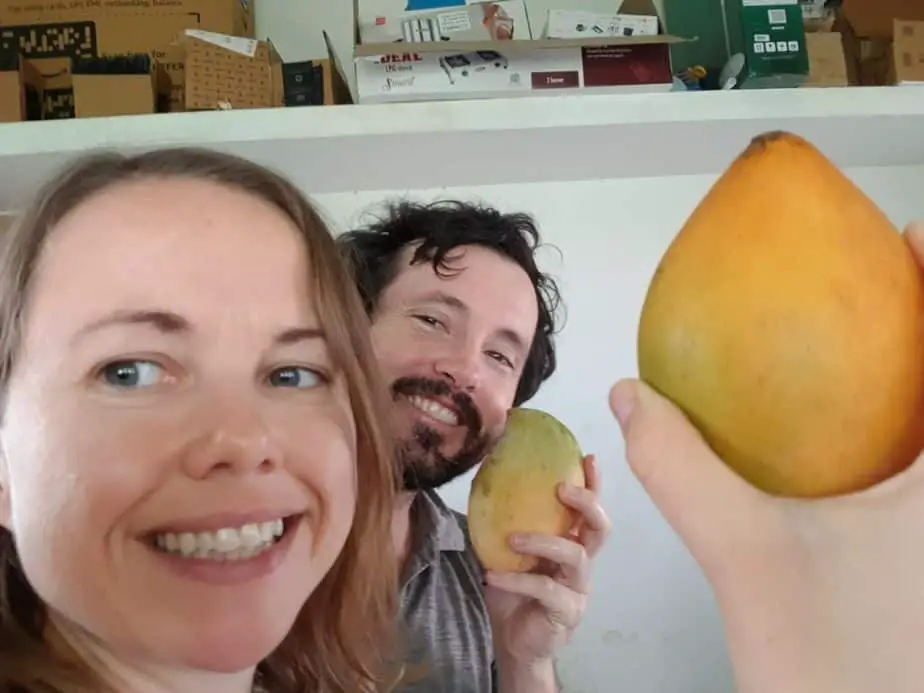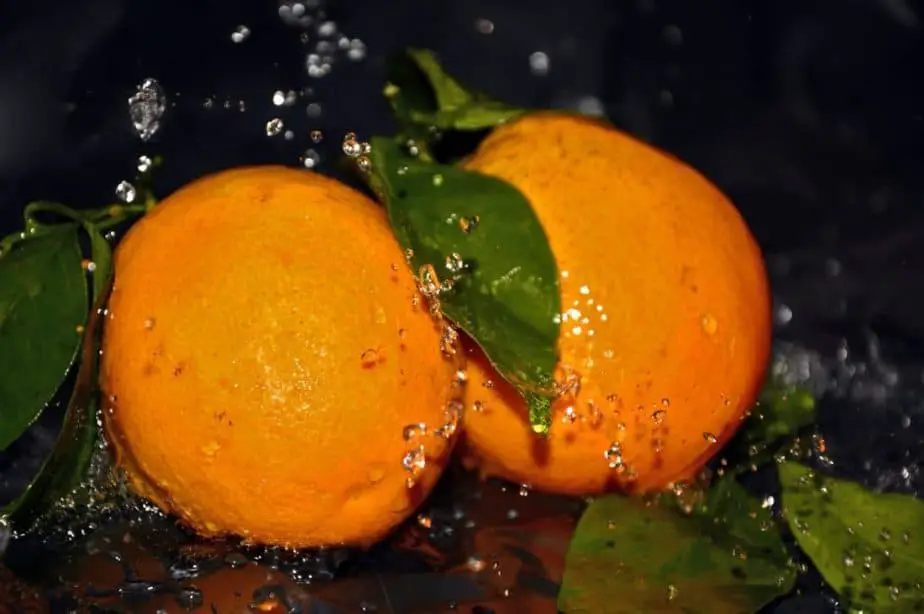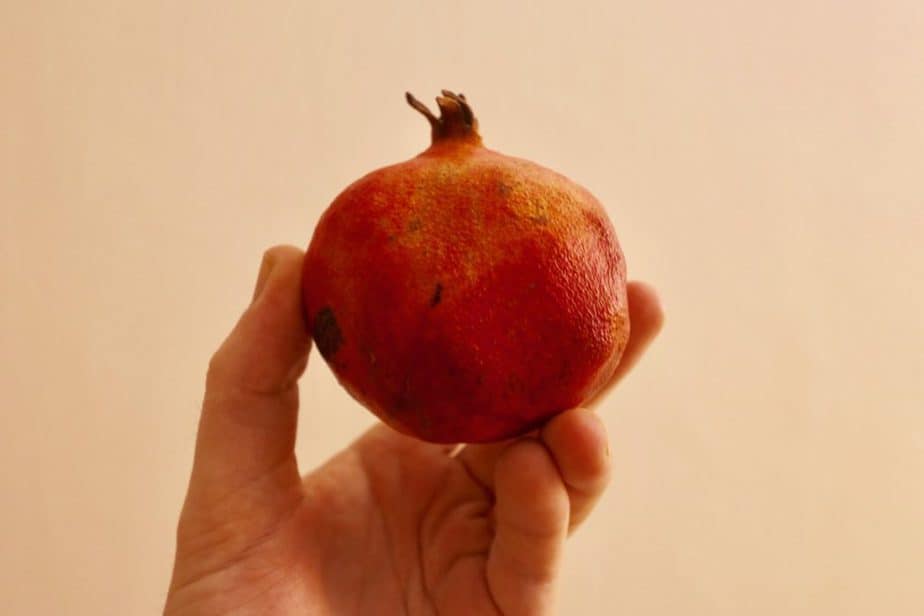A friend was coming to visit me in India and I had asked her, which of the delicious foods she’d MOST like to try… “the fruit!” she said.
How can you stay safe eating fruit in India? Peel it, boil it or avoid it… That’s your best bet to stay safe. Some tourists can’t resist so will wash their thin-skinned fruits with filtered or bottled water. Washing fruits with water mixed with a 1% baking soda solution removes more chemicals than just water alone.
When you’re walking down the streets in India, there are many wooden carts with bright colorful fruit stacked up. After sightseeing, many of the fruits are going to look very delicious, and they will probably taste that way too.
But pesticides, fertilizers, bacteria, and the hygiene of someone who’s cut the fruit… could be a real buzzkill if you end up getting sick from eating the fruit.
I’ve been in India for almost a year now, and I indulge in delicious fruits, but I do certain things to stay safe…
Buy Fruits You Can Peel

The best advice is: Peel it, boil it, or avoid it. 🤓
It’s not just in India, but anywhere in the world, it’s common practice for farmers and fruit sellers to spray the produce with less-than-healthy chemicals to improve sales.
The Environmental Working Group found that 70% of conventionally grown fruits and vegetables contain up to 230 different pesticides…
-Environmental Working Group in this study
The farmers might add pesticides or insecticides to keep bugs from eating the fruit. The fruit sellers may spray the produce with chemicals to give them a more edible-looking shine, so you’ll buy them.
Plus, even if they were washed, local tap water was probably used which presents another risk for your health.
The fruit will tempt you in India, and it may not be safe for consumption.
When I first arrived in India, I was clueless, haha. I would go up to the stands and buy pre-cut fruit [cue the scary horror movie music!] which is a big no-no.
I ate papayas and watermelon and loved the taste. Fortunately, I didn’t get sick, because pre-cut fruit poses an additional risk.
One day I was sitting near the pre-cut fruit stand that I often at papaya at, and I was watching the vendor cut his fruit. That’s when it hit me… He was holding the bare fruit in his hand, and cutting it. I didn’t see him wash his hands really good, and I didn’t see him wash his knife really well either… Usually, he’s sitting there and smoking cigarettes. Hmm.
Thinking about his hands all over the fruit has kept me far away from the papaya, sadly. Plus, the fruit will often sit out in the hot sun.
Now when I buy fruit on the street, I choose the fruits that have a thick peel:
- Bananas
- Coconuts
- Pineapple
- Jackfruit
- Watermelon
- Papayas
- Oranges
- Pomegranates
- Limes (they call them lemons here 🙂
One thing to consider is: You want to wash the peel if you can. Or peel your fruit with one hand, and eat it with the other.
If there are contaminants on the peel, so you don’t want to touch it, then touch the clean fruit.
I made a video about how to peel a banana with one hand if you were confused like I was about how to accomplish this.
Are Mangoes Safe to Eat in India?

India is known for it’s mangoes and when you taste them you will know why. 😋
I read a book, The Last Mughal, a story of the last Mughal ruler Bahadur Shah Zafar in Delhi and the uprising against the British in 1857.
One of my favorite parts was a story about famous poet in Delhi who was describing his love of mangoes and how he’d eat them until he got sick every night. Now I eat mangoes with a similar gusto just to pay my respects 😉
The problem with mangoes though is: The peel is thinner than other fruits like bananas and such.
I still eat them, but I will bring them home and wash them good, and not eat too close to the peel.
Another problem with mangos is: Since they are such a moneymaker for the agriculture industry artificial ripeners are used to get them ready to eat faster.
Calcium carbide is the chemical used to ripen it quickly. The Food Safety and Standards Authority of India (FSSAI) states that it is a carcinogen and it is not to be used in growing mangoes. Yet it still happens according to this story.
The side effects of eating this chemical can lead to hormonal imbalances or other diseases such as diabetes or cancer.
I wouldn’t worry too much. It seems like this type of article that is written about most things, but just be smart as you probably already are, when you are picking your fruit and clean it well.
How do you find natural mangoes?
- Look for ugly fruit. If a mango is grown naturally, it’s not going to look as nice as one that has been pumped full of chemicals. You will see marks and a duller green color.
- Look for green and yellow spots.
- Look for a red-yellow fruit. If they are ripened quickly with chemicals it will be a light yellow.
- Natural mangos are juicer and sweeter. If you cut it and juice runs everywhere, then you have a natural one.
Wash Your Fruits

If you want to have more of a selection of fruits, then you can wash your fruits before eating them to reduce your risk.
In this video about a study, scientists coated some apples with pesticides. Then they washed the apples with three solutions:
- Tap water only
- 1% baking soda and water solution
- Clorox bleach solution
Guess which one gave us the cleanest apples? If you said baking soda, you are a genius 🙂
Add a little baking soda to water and wash up those fruits to decrease your risk of getting chemicals in your fruit.
You could also try washing your fruit with grapeseed extract. It is an all-natural way to reduce bacteria and parasites. You can find it in pharmacies here in India or at home.
You can find grape seed extract in pills or as a liquid. You can add a few drops to a bowl of water, before washing your fruits with it. Then rinse with fresh bottled water.
Potassium permanganate is another one you can find in a pharmacy. Add a pinch to a bowl of water, it will turn purple, and you can wash your vegetables. Then rinse it with bottled water.
You could get high tech and buy an Ozonator. It is a machine that I saw mentioned in a local restaurant’s menu and found on Amazon. It is a clean way to wash fruits and vegetables. This is the one restaurant I’ve never had a problem at either and trust their food.
The Best Fruits To Eat in India to Stay Safe and Healthy

I hope this article doesn’t scare you off from eating fruit in India. India is the second-largest producer of fruit in the world, there’s plenty of delicious and safe fruit to enjoy:
I eat a lot of bananas. They’re so cheap, delicious and nutricious.
I love papayas on hot days. So juicy and not as sweet as some of the other fruits.
Coconut water is rejuvenating after a hike.
Pomegranates are tart and help me get energized to write and work.
Mangoes are tough to beat. They are like nature’s candy.
I have limes with mineral water every day, for a regular dose of Vitamin C. It’s like making my own lime-flavored LaCroix.
Jackfruit are so weird looking, I want to try them.
Starting to Feel Sick? Try this…
I have used a number of remedies to stay safe as I’ve been traveling in India:
- Activated charcoal pills: Take it if you feel your stomach rumbling. It will help flush out the toxins.
- Grapefruit seed extract: I prefer the liquid concentrate and it’s not cheap, but it has a lot of antioxidants while also helping repair stomach damage. Some travelers use it for prevention and take it before meals, but I only use it if my stomach rumbles or if I’m feeling sick.
Related Questions:
Is It Safe to Eat Bananas in India?
Yes! It has a peel so it is one of the safest fruits to eat in India. Peel it with one hand and eat it with the other.
Is Bread Safe to Eat in India?
Yes. Bread is cooked, so it’s safe to eat. India has a number of healthy flatbreads too, like roti, chapati and parotta. They have to be cooked right before serving so they are a safe bet in a restaurant.
What to Eat to Avoid Sickness in India?
Vitamin C – I squeeze limes into my mineral water each day. I take probiotics. I eat pomegranates occasionally which are packed with antioxidants. I drink a green vegetable concentrate every day as well with spirulina, amla powder, moringa, wheatgrass, and other nutritious things.
What do Tourists get Sick in India?
If you grow up in India, your stomach and body develop a tolerance for the local bacteria and microorganisms. However, if you grow up somewhere else, you are tolerant to a whole other set of bacteria and could get sick more easily in India. Plus, the tap water in India is not fit to drink, and many tourists don’t know that. Or they don’t know how many things tap water may touch. For instance, if someone washes a plate in it, they could get sick. There are also fewer food regulations in India as well, so there can be more contaminants in the food.
How to Safely Eat Raw Vegetables in India?
Peel it, boil it, or avoid it. If you peel off the skin, it will have most of the chemicals on it and the inside will be clean. If you cook it, then you will kill many of the bacteria inside. You could wash it using a 1% baking soda and water solution, as that has been found to remove more chemicals than water alone. You could also buy an ozonator – a machine that removes chemicals from fruits and vegetables.

